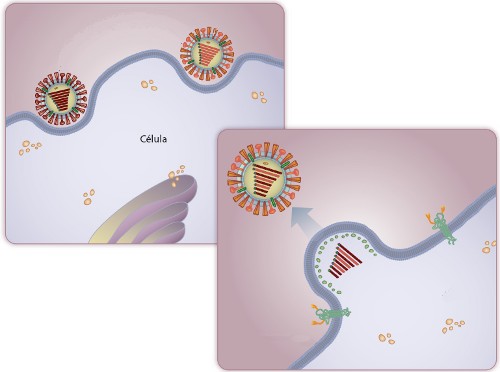February 9, 2010
Diversity of the Influenza and the reassortment
One of the most important characteristics to be considered about the Influenza, in the preparation for pandemics, is the reassortment. A mixture of genes of two or more different viruses is able to generate a new variety. Such as the new Influenza A (H1N1).
![]() Although the mutations have an important role in the diversity of the Influenza, and contribute a lot in order to develop new annual vaccines, the rearrangement causes a sudden antigenic variation (antigenic shift) that can generate a completely new virus for our immune system.
Although the mutations have an important role in the diversity of the Influenza, and contribute a lot in order to develop new annual vaccines, the rearrangement causes a sudden antigenic variation (antigenic shift) that can generate a completely new virus for our immune system.
The reassortement is a result of the Influenza cycle and of its 8 genes. When the virus enters the cell, its genes replicate in the nucleus and leave it to the cytoplasm to be encapsulated. All 8 genes have to enter the new viral particle in order for it to be infective. Therefore, each gene has a signal sequence that interacts with the M1 protein, from the structure of the viral particle. However, this signal is similar even in different viruses, and the genes from one can be encapsulated together with the genes from another.

When two different influenzas enter a same cell, its genes can be reassorted in the formation of new viral particles.
With this, in rare events (rare in relation to the infections by a single virus) in which the two different influenzas enter the same cell, different mosaics of genes can be formed in the particles that will leave. Most of these combinations are not viable, but some among the thousands that may be infectious, and an even smaller percentage can be more infectious than the original viruses. This is reassortment.
The lottery of rearssortment, where the genes are mixed up and chosen randomly, can give origin to very dangerous Influenza lineages. Simply think about the possibility of the highly pathogenic H5N1 acquiring genes that help them spread more efficiently or, in the case of Influenza A (H1N1), acquiring genes that increase the severity of the flu it causes.
This is how the Influenza is reassorted and mixed with genes in birds, pigs and humans. And given the damage caused by these hybrid variants, this is a fundamental event in the appearance of pandemic lineages. The reassortment has the advantage to bring new components to its genome.
Viral genes of mammals already adapted to grow in a body temperature of the host of about 37°C, against the temperature of about 40°C in birds, mix with the new avian HA and NA that will not be recognized by the antibodies. A change greater than mutations. The pigs play an important role here. Not only they live among humans and domestic birds, but also have both types of membrane receptor. Therefore, they may be infected by the avian and human virus and provide an environment with conditions where the hybrid adapts to our metabolism.
Events like this resulted in viruses that caused most of the flu pandemics. Although the H1N1 of 1918 seems to be a virus that originated directly from birds to humans (regardless having passed through pigs before it or not, it was probably transmitted as a whole virus), in 1957, a reassortment event with an avian virus resulted in new HA and NA that allowed the virus to cause much more damage in the so-called Asian Flu. In 1968, a reassortment occurred again where the virus acquired a new avian Hemagglutinin and caused the Hong Kong Flu.
Even reassortment events within the same lineage are able to cause more severe diseases and failure in the coverage of the vaccine, like the flu outbreaks of 1947, 1851, 1997 and 2003. The first two were events due to H1N1 reassortments and the last two of the human H3N2.
In 2009, we have experienced another reflex of the reassortment, this time with the swine virus. In 1918, the avian H1N1 circulated both in humans and in pigs, generating different lineages, present until today. In 1997, a new swine virus appeared in North America, of a triple reassortment, with a combination of human (our H3N2 generated in 1968), swine and avian Influenza genes. It is the swine H1N2. – The European pigs were virtually flu-free until 1976 when the swine H1N1 was brought in a shipment of pigs from North America. This was quickly substituted by an avian H1N1 in 1979.
Lastly, in 2008, the triple reassortant circulating in pigs in North America reassorted again with the Eurasian H1N1 swine virus. It is not yet known if this event occurred in pigs or in humans. It is more likely that it occurred in humans, as contaminated pigs have not yet been found. This new Influenza A (H1N1) contaminated humans and is causing the current pandemic.
Sources:
Palese, P. (2004). Influenza: old and new threats Nature Medicine, 10 (12s) DOI: 10.1038/nm1141
Morens, D., Taubenberger, J., & Fauci, A. (2009). The Persistent Legacy of the 1918 Influenza Virus New England Journal of Medicine, 361 (3), 225-229 DOI: 10.1056/NEJMp0904819


[...] an ecological point of view, the possibility of a same pig being infected by two different viruses, giving origin to a new rearranged lineage must be accounted. The chances are high given that, as pigs are able to be infected with the avian [...]